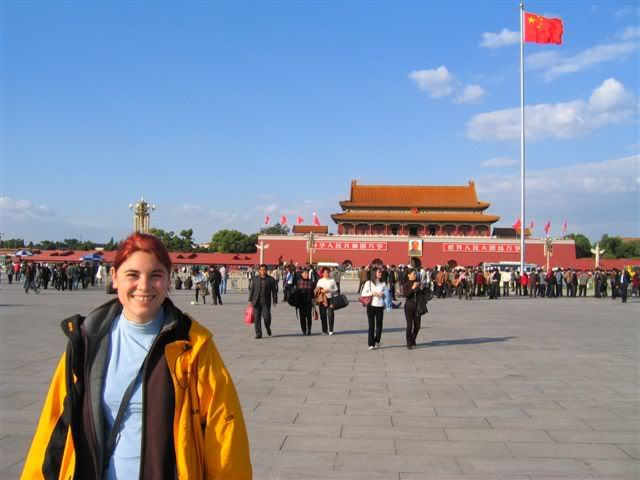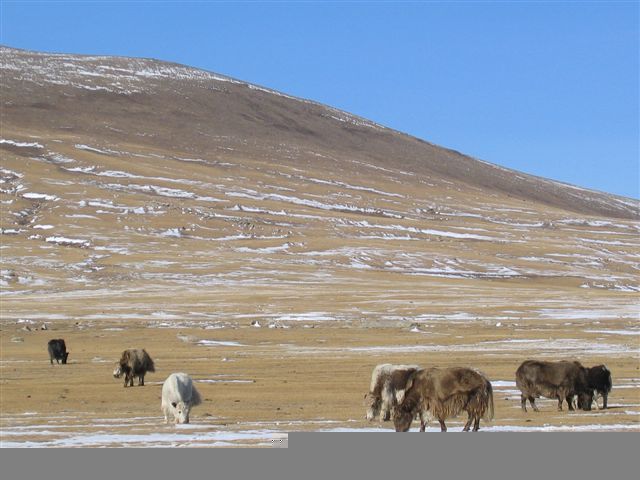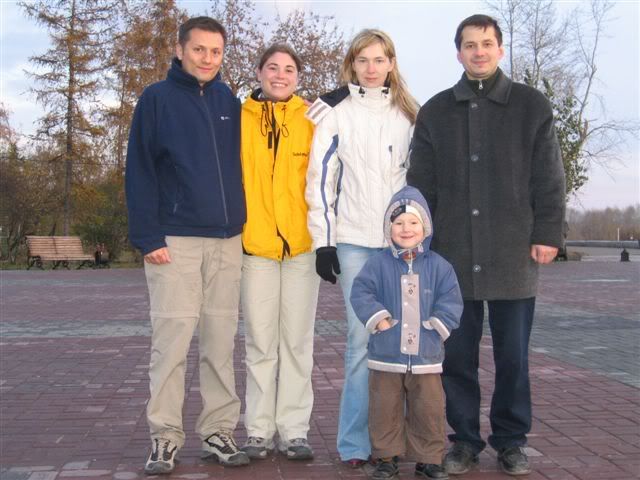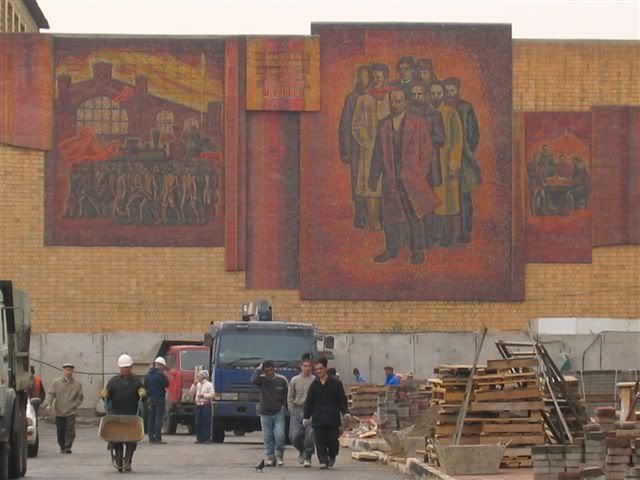Friday, October 29, 2004
Beijing
Welcome in China! Our first experience of the "Empire of the Middle" couldn't be more positive. The atmosphere of Beijing is rather laid-back and the people are helpful. We ended up staying 11 days there, which, for such a huge metropole is hardly enough to scratch the surface.
We in a backpacker hotel in the lively hutongs near Qianmen and Tiananmen square. An ideal location to meet travellers, get good food (including the famous and, in our opinion, slightly over-rated Peking duck), organise trips and explore the city by foot, bus or underground.

... on Tiananmen square:

Of course, we did the usual tourist program: temples, palaces, gardens... We started with the forbidden city, which needs a whole day to visit well:

South of the forbidden city, surrounded by a beautiful park, lies the so-called heavenly temple, where the emperor performed in the ceremonies for good harvests.

Outside the centre, the new summer palace is also a must. Huge lake and park, and, on and around the hill, temples , an opera, official buildings... Unfortunately, like often in Beijing, there was a bit of smog on the day we went there.

But beside those showcase remants of the imperial ages, Beijing is also a very lively place. The people are, on the whole, a joyful lot who, on weekends, gather in masses in the park for impromptu recitals, dances and other outdoor games.

On the really smoky days, we did some shopping at the places where designer wares and DVDs are cheap, getting some precious experience at hardcore bargaining. And having fun in the process!
The Great Wall
One can't possibly stay in Beijing without doing at least a day trip to the Great Wall. So we did this as well, trying to find a spot to avoid the crowd. We went to the less renovated portion at Jinshanlin, from where we walked on the wall to Simatai. A beautiful and scenic 10km hike that seems to discourage the masses.

We in a backpacker hotel in the lively hutongs near Qianmen and Tiananmen square. An ideal location to meet travellers, get good food (including the famous and, in our opinion, slightly over-rated Peking duck), organise trips and explore the city by foot, bus or underground.

... on Tiananmen square:

Of course, we did the usual tourist program: temples, palaces, gardens... We started with the forbidden city, which needs a whole day to visit well:

South of the forbidden city, surrounded by a beautiful park, lies the so-called heavenly temple, where the emperor performed in the ceremonies for good harvests.

Outside the centre, the new summer palace is also a must. Huge lake and park, and, on and around the hill, temples , an opera, official buildings... Unfortunately, like often in Beijing, there was a bit of smog on the day we went there.

But beside those showcase remants of the imperial ages, Beijing is also a very lively place. The people are, on the whole, a joyful lot who, on weekends, gather in masses in the park for impromptu recitals, dances and other outdoor games.

On the really smoky days, we did some shopping at the places where designer wares and DVDs are cheap, getting some precious experience at hardcore bargaining. And having fun in the process!
The Great Wall
One can't possibly stay in Beijing without doing at least a day trip to the Great Wall. So we did this as well, trying to find a spot to avoid the crowd. We went to the less renovated portion at Jinshanlin, from where we walked on the wall to Simatai. A beautiful and scenic 10km hike that seems to discourage the masses.

Friday, October 22, 2004
Ulaan Baatar
Not much to say about Ulaan Bataar, the capital of Mongolia. During the
last 4 years, it has experienced rapid development. Lots of banks and cars
have appeared downtown, so no more horse riders on Suhbataar square as Lonely
Planet suggested.

But the city is still quite agreeable and laid back.

... spinning the prayer wheels at the Gandan Khiid monastery:

At this time of the year, it also starts to get quite cold (-9ºC and sunny
at noon at the beginning of the week), as these icicles at the Bogd Khan
winter palace attest:

last 4 years, it has experienced rapid development. Lots of banks and cars
have appeared downtown, so no more horse riders on Suhbataar square as Lonely
Planet suggested.

But the city is still quite agreeable and laid back.

... spinning the prayer wheels at the Gandan Khiid monastery:

At this time of the year, it also starts to get quite cold (-9ºC and sunny
at noon at the beginning of the week), as these icicles at the Bogd Khan
winter palace attest:

Wednesday, October 13, 2004
Gobi Desert Tour and Karkhorin
First thing after having done the usual travel overhead routine in Ulaan Baatar, I hopped on the next available tour to the explore the vast Gobi desert, which occupies most of the south of Mongolia.

The itinary went down south through Bayanzag and Dalanzadgad, followed the Gurvansaikan national park westwards and then headed up for a last stop in Karkhorin, where the capital of Genghis Khan's empire once stood. The whole trip took 9 days.
The Gobi desert landscape is extremely varied, ranging from arid burnt out black gravel plateaux to sand dunes, snow topped mountains, red earth cliffs, shrub forrests, grassy plains with rivers and lakes, a valley where the ice never melts, etc. Every day brought other sceneries, so there was no time to get bored!

...a dinosaur bone:

...entering the ice valley:

The desert is also teeming with life. The most visible are the thousands of gerbils, marmots, and low flying small birds. Also a very common sight were the herds of sheep, goats, cows, yaks, gazelles, wild donkeys, horses and camels, as well as the buzzards gliding high in search of carrion. And, of course, the dispersed human population and its gers.

... after the rain:

We travelled by jeep: 4-8 hours drives almost every day. In the evening, we stayed in traditional gers rented by the locals. Sometimes, we got a stove for heating. In any case, a good sleeping bag was a must as it could get very cold at night. Often, our bottled water freezed in the jeeps.

During the day, the temperature hardly got over 10ºC which, combined with the dryness of the climate was rather a good thing, as it prevented the formation of body odour. We only had 1 possibility to take a shower, at the public facilities in Dalanzadgad, on day 3 of the trip...
Besides sightseeing, we also had a good share of fun and some interesting ethnic experiences. The most memorable without doubt being the Mongolian wedding where we got invited to the reception in the ger after the ceremony. Plates of food and snacks were passed between the guests: pieces of freshly killed mutton, noodle soup, cabbage salad, apples and dried raisins, sundried sheep and camel milk... All of this washed down by generously filled chalices of alcohol.
I distinguished 3 varieties of drinks: the mild airag (foamy horse milk beer after which one was requested to sing), the treacherous camel milk spirit (like fermented lactoserum) and the deadly "Mongol Standard" vodka. The hosts kept the supplies coming and, under those circumstances, it is very bad manners not to down your cup. So the atmosphere got very relaxed and joyful.

Then things got blurred... Eventually, in the early afternoon, the activity in the ger decreased while the desert got littered with alcoholised corpses. My lights went back on at 6pm. The hosts were very happy: the alcohol had been drunk and, judging by the bodycount, the guests had enjoyed themselves. Good! Yes!
Karkhorin
This town is not really in the Gobi desert, but as it is more or less on the way back to Ulaanbataar, most Gobi tours do a stop there. Seeing the sleepy shabby frontier-like town it has become, it is hard to imagine that this place was the center of the world in the 14th century, when it was the capital of the biggest empire of all times. But the successive destructions and invasions left absolutely nothing of the Genghis Khan's first capital (at the end of his reign, he moved to Beijing, which became his new capital).
The only interest of stopping there is probably the tibetan buddhist Erdene Zuu temples, which were built in 1770 and almost completely destroyed by the communists during the purges of 1940. They are now slowly being restored.

... the group on its last stop:


The itinary went down south through Bayanzag and Dalanzadgad, followed the Gurvansaikan national park westwards and then headed up for a last stop in Karkhorin, where the capital of Genghis Khan's empire once stood. The whole trip took 9 days.
The Gobi desert landscape is extremely varied, ranging from arid burnt out black gravel plateaux to sand dunes, snow topped mountains, red earth cliffs, shrub forrests, grassy plains with rivers and lakes, a valley where the ice never melts, etc. Every day brought other sceneries, so there was no time to get bored!

...a dinosaur bone:

...entering the ice valley:

The desert is also teeming with life. The most visible are the thousands of gerbils, marmots, and low flying small birds. Also a very common sight were the herds of sheep, goats, cows, yaks, gazelles, wild donkeys, horses and camels, as well as the buzzards gliding high in search of carrion. And, of course, the dispersed human population and its gers.

... after the rain:

We travelled by jeep: 4-8 hours drives almost every day. In the evening, we stayed in traditional gers rented by the locals. Sometimes, we got a stove for heating. In any case, a good sleeping bag was a must as it could get very cold at night. Often, our bottled water freezed in the jeeps.

During the day, the temperature hardly got over 10ºC which, combined with the dryness of the climate was rather a good thing, as it prevented the formation of body odour. We only had 1 possibility to take a shower, at the public facilities in Dalanzadgad, on day 3 of the trip...
Besides sightseeing, we also had a good share of fun and some interesting ethnic experiences. The most memorable without doubt being the Mongolian wedding where we got invited to the reception in the ger after the ceremony. Plates of food and snacks were passed between the guests: pieces of freshly killed mutton, noodle soup, cabbage salad, apples and dried raisins, sundried sheep and camel milk... All of this washed down by generously filled chalices of alcohol.
I distinguished 3 varieties of drinks: the mild airag (foamy horse milk beer after which one was requested to sing), the treacherous camel milk spirit (like fermented lactoserum) and the deadly "Mongol Standard" vodka. The hosts kept the supplies coming and, under those circumstances, it is very bad manners not to down your cup. So the atmosphere got very relaxed and joyful.

Then things got blurred... Eventually, in the early afternoon, the activity in the ger decreased while the desert got littered with alcoholised corpses. My lights went back on at 6pm. The hosts were very happy: the alcohol had been drunk and, judging by the bodycount, the guests had enjoyed themselves. Good! Yes!
Karkhorin
This town is not really in the Gobi desert, but as it is more or less on the way back to Ulaanbataar, most Gobi tours do a stop there. Seeing the sleepy shabby frontier-like town it has become, it is hard to imagine that this place was the center of the world in the 14th century, when it was the capital of the biggest empire of all times. But the successive destructions and invasions left absolutely nothing of the Genghis Khan's first capital (at the end of his reign, he moved to Beijing, which became his new capital).
The only interest of stopping there is probably the tibetan buddhist Erdene Zuu temples, which were built in 1770 and almost completely destroyed by the communists during the purges of 1940. They are now slowly being restored.

... the group on its last stop:

Tuesday, October 05, 2004
Irkutsk and Lake Baikal
Sun at last! The siberian we've been longing to see finally materialised... Bright colours and crisp fresh air.

Irkutsk is pretty, small and manageable and all transiberian tourists seem to converge there (who, at this season, are almost exclusively swiss and dutch!). The town also still has lots of traditional wooden houses, parks and a pedestrian street.

... siberian windows:

Lake Baikal is 70 km from Irkutsk. A good day trip by taxi-bus. Like most people, we went to Listvyanka, the picturesque village on the lake's southern end. From there, we followed the scenic trails up the hill along the shore.

Not to be missed is the endemic onmul fish, which is sold either dried or smoked at the port.

... another window photo:

On our last day in Irkutsk, the snow started to fall. Walking around the streets, we met Sacha, a Russian with whom we travelled from Krasnoyarsk in the train compartement. He very kindly invited us at his place to meet his wife and son. We eat there and then they drove us around to the Baikal Seal Aquarium and the river promenade: a very nice memory to leave Russia!


Irkutsk is pretty, small and manageable and all transiberian tourists seem to converge there (who, at this season, are almost exclusively swiss and dutch!). The town also still has lots of traditional wooden houses, parks and a pedestrian street.

... siberian windows:

Lake Baikal is 70 km from Irkutsk. A good day trip by taxi-bus. Like most people, we went to Listvyanka, the picturesque village on the lake's southern end. From there, we followed the scenic trails up the hill along the shore.

Not to be missed is the endemic onmul fish, which is sold either dried or smoked at the port.

... another window photo:

On our last day in Irkutsk, the snow started to fall. Walking around the streets, we met Sacha, a Russian with whom we travelled from Krasnoyarsk in the train compartement. He very kindly invited us at his place to meet his wife and son. We eat there and then they drove us around to the Baikal Seal Aquarium and the river promenade: a very nice memory to leave Russia!

Saturday, October 02, 2004
Krasnoyarsk
... on the way, a stop at Novossibirsk train station:

After a 2 nights train ride across Siberia, we finally arrived in Krasnoyarsk, one of the former sovietic secret cities.

Surrounded by hills, Krasnoyarsk is surprinsingly agreable and relaxed. Or atmospheric as "Lonely Planet" could say... A good place for a short stay.

Unfortunately, the weather wasn't quite optimal, but we still managed to trek the famous Stolby Natural Reserve and it's rock formations on a relatively sunny afternoon.


After a 2 nights train ride across Siberia, we finally arrived in Krasnoyarsk, one of the former sovietic secret cities.

Surrounded by hills, Krasnoyarsk is surprinsingly agreable and relaxed. Or atmospheric as "Lonely Planet" could say... A good place for a short stay.

Unfortunately, the weather wasn't quite optimal, but we still managed to trek the famous Stolby Natural Reserve and it's rock formations on a relatively sunny afternoon.

